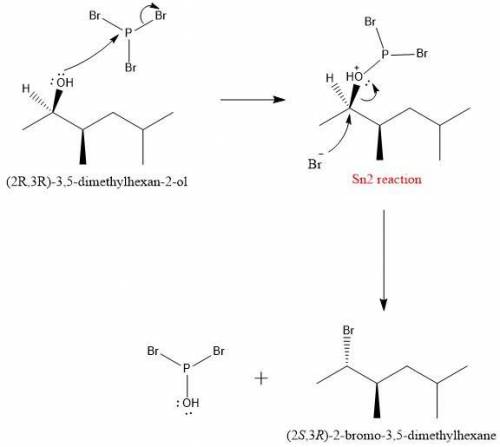
Chemistry, 01.08.2020 02:01 Jonny13Diaz
Draw the curved arrow mechanism for the reaction between (2R,3R)-3,5-dimethylhexan-2-ol and PCl3.

Answers: 3


Other questions on the subject: Chemistry

Chemistry, 21.06.2019 14:20, kkakk19
Calculate the enthalpy of the following reaction: 4 b (s) + 3 o2 (g) → 2 b2o3 (s) given the following pertinent information: (a) b2o3 (s) + 3 h2o (g) → 3 o2 (g) + b2h6 (g), δhoa = +2035 kj (b) 2 b (s) + 3 h2 (g) → b2h6 (g), δhob = +36 kj (c) h2 (g) + latex: \frac{1}{2} 1 2 o2 (g) → h2o (l), δhoc = −285 kj (d) h2o (l) → h2o (g), δhod = +44 kj
Answers: 3


Chemistry, 21.06.2019 22:30, mimireds5419
1. combine iron and copper (ii) sulfate solution. (hint: iron will form the iron (iii) ion) fe + cuso4 → 2. combine lead (ii) nitrate and potassium iodide solutions. pb(no3)2+ kl → 3. combine magnesium metal and hydrochloric acid solution. mg + hcl → 4. electrolysis (splitting) of water. h2o → 5. burning magnesium. mg + o2 →
Answers: 3

Chemistry, 21.06.2019 23:00, daryondaniels28
What is the maximum amount of al2(so4)3 which could be formed from 15.84 g of al and 12.89 g of cuso4?
Answers: 2
You know the right answer?
Draw the curved arrow mechanism for the reaction between (2R,3R)-3,5-dimethylhexan-2-ol and PCl3....
Questions in other subjects:

Physics, 17.07.2019 19:00

History, 17.07.2019 19:00

Mathematics, 17.07.2019 19:00

Mathematics, 17.07.2019 19:00

Mathematics, 17.07.2019 19:00


Mathematics, 17.07.2019 19:00

Mathematics, 17.07.2019 19:00


 to produce a new bond between O and P with a positive charge in the oxygen. Additionally, when the OH attacks a Br atom leaves the molecule producing a bromide ion.
to produce a new bond between O and P with a positive charge in the oxygen. Additionally, when the OH attacks a Br atom leaves the molecule producing a bromide ion.  . An Sn2 reaction takes place and the substitution would be made in only one step. Due to this, we will have an inversion in the stereochemistry and the absolute configuration on carbon 2 will change from "R" to "S" to produce (2S,3R)-2-bromo-3,5-dimethylhexane.
. An Sn2 reaction takes place and the substitution would be made in only one step. Due to this, we will have an inversion in the stereochemistry and the absolute configuration on carbon 2 will change from "R" to "S" to produce (2S,3R)-2-bromo-3,5-dimethylhexane.



